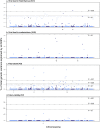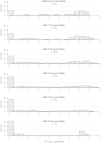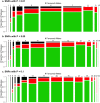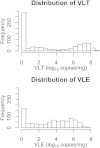A genome-wide association study of fetal response to type 2 porcine reproductive and respiratory syndrome virus challenge
- PMID: 26846722
- PMCID: PMC4742883
- DOI: 10.1038/srep20305
A genome-wide association study of fetal response to type 2 porcine reproductive and respiratory syndrome virus challenge
Abstract
Control of porcine reproductive and respiratory syndrome (PRRS) is economically important for the swine industry worldwide. As current PRRS vaccines do not completely protect against heterologous challenge, alternative means of control, including enhanced genetic resilience, are needed. For reproductive PRRS, the genetic basis of fetal response to PRRS virus (PRRSV) infection is poorly understood. Genome-wide association studies (GWAS) were done here using data from 928 fetuses from pregnant gilts experimentally challenged with type 2 PRRSV. Fetuses were assessed for viral load in thymus (VLT), viral load in endometrium (VLE), fetal death (FD) and fetal viability (FV), and genotyped at a medium density. Collectively, 21 candidate genomic regions were found associated with these traits, seven of which overlap with previously reported QTLs for pig health and reproduction. A comparison with ongoing and related transcriptomic analyses of fetal response to PRRSV infection found differentially expressed genes within 18 candidate regions. Some of these genes have immune system functions, and have been reported to contribute to host response to PRRSV infection. The results provide new evidence about the genetic basis of fetal response to PRRSV challenge, and may ultimately lead to alternative control strategies to reduce the impact of reproductive PRRS.
Figures






Similar articles
-
Genome-wide analysis of the transcriptional response to porcine reproductive and respiratory syndrome virus infection at the maternal/fetal interface and in the fetus.BMC Genomics. 2016 May 20;17:383. doi: 10.1186/s12864-016-2720-4. BMC Genomics. 2016. PMID: 27207143 Free PMC article.
-
Variation in fetal outcome, viral load and ORF5 sequence mutations in a large scale study of phenotypic responses to late gestation exposure to type 2 porcine reproductive and respiratory syndrome virus.PLoS One. 2014 Apr 22;9(4):e96104. doi: 10.1371/journal.pone.0096104. eCollection 2014. PLoS One. 2014. PMID: 24756023 Free PMC article.
-
Maternal and fetal predictors of fetal viral load and death in third trimester, type 2 porcine reproductive and respiratory syndrome virus infected pregnant gilts.Vet Res. 2015 Sep 25;46:107. doi: 10.1186/s13567-015-0251-7. Vet Res. 2015. PMID: 26407558 Free PMC article.
-
Novel insights into host responses and reproductive pathophysiology of porcine reproductive and respiratory syndrome caused by PRRSV-2.Vet Microbiol. 2017 Sep;209:114-123. doi: 10.1016/j.vetmic.2017.02.019. Epub 2017 Mar 2. Vet Microbiol. 2017. PMID: 28292546 Review.
-
Genetic control of host resistance to porcine reproductive and respiratory syndrome virus (PRRSV) infection.Virus Res. 2010 Dec;154(1-2):161-9. doi: 10.1016/j.virusres.2010.08.004. Epub 2010 Aug 13. Virus Res. 2010. PMID: 20709118 Review.
Cited by
-
Genome-wide analysis of the transcriptional response to porcine reproductive and respiratory syndrome virus infection at the maternal/fetal interface and in the fetus.BMC Genomics. 2016 May 20;17:383. doi: 10.1186/s12864-016-2720-4. BMC Genomics. 2016. PMID: 27207143 Free PMC article.
-
proBDNF expression induces apoptosis and inhibits synaptic regeneration by regulating the RhoA-JNK pathway in an in vitro post-stroke depression model.Transl Psychiatry. 2021 Nov 10;11(1):578. doi: 10.1038/s41398-021-01667-2. Transl Psychiatry. 2021. PMID: 34759285 Free PMC article.
-
A DIO2 missense mutation and its impact on fetal response to PRRSV infection.BMC Vet Res. 2024 Jun 12;20(1):255. doi: 10.1186/s12917-024-04099-4. BMC Vet Res. 2024. PMID: 38867209 Free PMC article.
-
Xenotransplantation: Progress Along Paths Uncertain from Models to Application.ILAR J. 2018 Dec 31;59(3):286-308. doi: 10.1093/ilar/ily015. ILAR J. 2018. PMID: 30541147 Free PMC article.
-
Compensatory mechanisms in response to induced hypothyroidism in the late gestation pig fetus†.Biol Reprod. 2023 May 10;108(5):731-743. doi: 10.1093/biolre/ioad024. Biol Reprod. 2023. PMID: 36811850 Free PMC article.
References
-
- Faaberg K. S. et al. Arteriviridae in Virus Taxonomy: Ninth Report of the International Committee on Taxonomy of Viruses (eds. King A. M. Q., Lefkowitz E., Adams M. J. & Carstens E. B.) 796–805 (Elsevier, 2012).
-
- Rossow K. D. Porcine reproductive and respiratory syndrome. Vet. Pathol. 35, 1–20 (1998). - PubMed
-
- Neumann E. J. et al. Assessment of the economic impact of porcine reproductive and respiratory syndrome on swine production in the United States. J. Am. Vet. Med. Assoc. 227, 385–392 (2005). - PubMed
-
- Holtkamp D. J. et al. Assessment of the economic impact of porcine reproductive and respiratory syndrome virus on United States pork producers. J. Swine Heal. Prod. 21, 72–84 (2013).
Publication types
MeSH terms
Substances
LinkOut - more resources
Full Text Sources
Other Literature Sources
Molecular Biology Databases
Research Materials

